Podocarpus falcatus
| Botanical Name | Podocarpus falcatus |
|||||||||||||||||||||||||||||||||||||||||
| Family | Podocarpaceae - The yellowood family. |
|||||||||||||||||||||||||||||||||||||||||
| Pronunciation | pod-oh-KAR-pus fal-KAY-tus |
|||||||||||||||||||||||||||||||||||||||||
| Common Name(s) |
English: Common Yellowwood; Bastard Yellowwood; Outeniqua Yellowwood; Smooth-barked Yellowwood
Afrikaans: Bastergeelhout; Gewone Geelhout; Outeniekwa-geelhout
IsiXhosa: Umkhoba; Umkolaya; Umngcondo
IsiZulu: Umgeya; Umhlenhlane; Umomphumelo; Umpume; Umsonti
Sesotho sa Leboa: Mogôbagôba
Tshivenda: Mufhanza
|
|||||||||||||||||||||||||||||||||||||||||
| Plant Group |
|
|||||||||||||||||||||||||||||||||||||||||
| Plant Size |
|
|||||||||||||||||||||||||||||||||||||||||
| Position |
|
|||||||||||||||||||||||||||||||||||||||||
| General Information |
|
|||||||||||||||||||||||||||||||||||||||||
| Specific Information | The Yellowood Family belongs to the Gymnospermae group of seed-bearing plants, meaning they produce cones rather than flowers. This places them in the same group as cycads, cypress, pine and fir trees. Podocarpus falcatus can reach a height of 45 m in nature but remains much smaller (about 15 m) when cultivated in a garden situation. This elegant tree has a long clean, cylindrical trunk with a slender crown and a light or crowded branching system. The leathery narrow leaves are blue-green when young, becoming dark green as they mature. The bark is smooth and ridged on younger stems and flakes off attractively on the trunk and older branches. The primitive cones are produced on separate male and female trees. The large, yellow, fleshy fruits are produced at the end of a woody stalk and take a year to ripen. The tree is chosen by many bird species for nesting. Podocarpus falcatus makes a striking tree for a seaside garden as it grows well in sandy soils and tolerates salt laden winds. Podocarpaceae are protected trees in South Africa, meaning that no person may cut, disturb, damage or destroy the tree, and their products may not be possessed, collected, removed, transported, exported, donated, purchased or sold - except under licence granted by the Department of Water Affairs and Forestry (or a delegated authority). |
|||||||||||||||||||||||||||||||||||||||||
| Ad Break | ||||||||||||||||||||||||||||||||||||||||||
| Flowers | ||||||||||||||||||||||||||||||||||||||||||
| Description | this tree does not bear flowers |
|||||||||||||||||||||||||||||||||||||||||
| Season |
|
|||||||||||||||||||||||||||||||||||||||||
| Colour | ||||||||||||||||||||||||||||||||||||||||||
| Growth Rate |
|
|||||||||||||||||||||||||||||||||||||||||
| Plant Uses |
|
|||||||||||||||||||||||||||||||||||||||||
| Distribution and Habitat | from the southern Western Cape Province, north-east through the Eastern Cape, KwaZulu-Natal, Mpumalange and Limpopo, as well as Swaziland and Mozambique, mainly in afromontane (mountain) forest, occasionally in coastal swamp forests, and also in wooded ravines in moist places |
|||||||||||||||||||||||||||||||||||||||||
| Planting Suggestions | The Outeniqua yellowwood grows well in all soil types provided it is well composted and receives adequate water. Trees benefit from a layer of mulch extending beyond the edge of the branches. This keeps roots cool and reduces moisture loss from the soil. Care must be taken when transplanting not to damage the taproot as this may slow the initial growth rate of the plant. The growth rate is average, from about 50 cm per year. This is an excellent container plant which can be used as an indoor Christmas tree. The old method of digging a deep hole and filling it with soil and compost has resulted in many trees failing to thrive, dying, rotting at the base or worse still, falling over in later years due to poor root development. Refer to the following sites for the best method of planting trees: International Society of Arboriculture: New Tree Planting Tree People: Plant the right way For those of you who have a clay problem try: |
|||||||||||||||||||||||||||||||||||||||||
| Medicinal Uses | Podocarpus falcatus is well known for its valuable pale yellow wood, traditionally used in the manufacture of fine furniture. The bark is used for tanning leather and the sap is used to treat chest complaints. Oil extracted from the seeds or fruits is used to treat gonorrhea. |
|||||||||||||||||||||||||||||||||||||||||
| Ad Break | ||||||||||||||||||||||||||||||||||||||||||


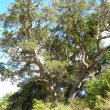
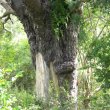
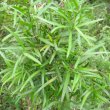
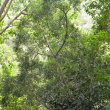
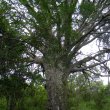


Comments
Podocarpus Falcatus seeds
I have 2 mature (planted 1978) trees at my home in Gauteng, which are now about 14 m tall, and which bear fruit with viable seeds approximately every 2-3 years. If the birds come along and carry off the fruit, are they breaking the law by "collecting,distributing or donating" the seeds to other neighbourhoods? How am I breaking the law by giving the seedlings to other gardeners or planting saplings in public parks or along watercourses? I thought that was what Arbour month was all about!
Podocarpus Falcatus (Outeniqua Yellowood)
This year is the first time we have seen a really HEAVY crop of fruit on our two trees, and also the first time a large gathering of African Green Pigeons (Treron Calvus), has been spending the day up there eating the fruit( up to 20 birds at a time!). As I said in 2013, they are now breaking the law by collecting and distributing said seeds all over the show. Hopefully some of these will take root along watercourses such as the Jukskei river, where currently mostly (55%) alien vegetation like bluegum is growing.
Comments
@ Charles Kuhn
Hey.
Great news on the 2 trees that you have. I totally get what you are saying with replanting them. However I must just bring to you attention that birds are part of natures course, whereas humans can deliberately interfere with nature to the detriment of the environment. Once again I am mainly talking here of national state parks. I am sure there is not much harm in letting people grow them in their gardens.
While the yellow woods are indigineous trees to South Africa, remember that it is only certain parts of South Africa where they actually are.
The laws are also there to stop people just planting things and presuming that they are helping when they could be doing more harm than not( Hence all the black wattle and gumtrees that are doing more damage as alien species).
You know exactly what tree you have there, remember most do not know that.
The only thing that got my attention in your statement was "public parks or along watercourses". If you are referring to state forests, then I'd be a bit careful as they are quiet harsh on anyone interfering with the national state forests. (Not disagreeing with the intention here just saying they are strict.)
But yes, I definitely say, depending where you live, spread the seeds around, you are helping in a big way!
I wish more people who owned indigenous trees like you would have the thoughts of planting the seeds.......
Young Yellowwood Trees Planted in High Density Sectional Title
I am 94 years old and ardent gardener and live with my son and family on a property filled almost exclusively with indeginous trees shrubs and a natural swimming pool. I have a property in a Sectional Title complex on the coast which is now nearly fully developed (all buildings completed) with very little space between building lines. I have many well established small to medium indeginous trees and shrubs on the property. Our neighbour has recently planted 3 Small (1meter) Yellowood trees in our portion of the land without our knowledge. On looking up the growth statistics on the tree it is very apparent that these trees will create a major problem down the road not only for ourselves but for our other neighbours (and dwellings) in the immediate vicinity and will eventually have to be cut down. These trees are still very young and could still possibly be transplanted. Would our neighbour or the "Body Corporate" not have had to apply for a permit to purchase and plant the trees and if not, other than warning our other neighbours of the potential problem they may face downd the road (the trees have been planted within 15 meters or less of the other properties) what else do you suggest I do as I believe that the planting of these trees in a densely built-up area is irresponsible. Tree lover
Hi.
Hi.
If it is still so young and you are concerned, you can have it transplanted. The roots themselves shouldn't cause any issue as they the taproot goes long, straight and deep, it doesn't really spread out. When they are planted in residential they usually stay between 10 - 15 meters high MAX. If it is on a "out of town" piece of property then it could get higher. I am not too sure what area you stay in but they generally only get huge in their natural habitat, the growth is also slow.
Your neighbor would not have needed a permit if he bought it from a nursery, as they will be allowed to sell them. (Yip the law in effect is quite useless)
I am not too sure on building requirements, if he would have needed "permission" for that.
By all means you could get it transplanted somewhere, personally I wouldn't really worry about it, unless it is planted above or near plumbing, water pipes and that sort of thing.
Try also to find out if it is Outiniqua or REAL yellowwood.
Podocarpus falcatus Bonsai
It is said that I cannot prune my Podocarpus falcatus Bonsai as it is not allowed in terms of the forest act for protected trees, according to DAFF. The tree was a gift and was originally bought from a nursery. DAFF will not issue a permit in this case. Is the intention of this act so narrow minded? How do I manage my miniature tree without pruning?
Outeniqua Yellowwood tree
I planted a 1m high Outeniqua Yellowwood tree in a 1/2m hole prepared with compost & bonemeal (as advised). I found Koffieklip about halfway down and loosened most with a pick-axe and dug what I could out. I do not know how far down this koffieklip goes, but am concerned it could stunt growth of the tree roots. Is my concern valid?
Koffieklip - Ferricrete - Duricrust - Hardpan
Hi Des
My sincere apologies for taking so long to reply to your query.
Yes I do think your concern is valid. Although I did not find much botanical information, what I did find is not encouraging.
Ferricrete impedes root growth so that vegetation consists of sparse grass, stunted shrubs and gnarled and stunted trees. Koffieklip retains almost no moisture and rapidly absorbs and reradiates solar heat. From what I can understand, Koffieklip layers may vary from a few centimeters to many meters.
As you have little topsoil, most root growth will be shallow and horizontal. Unless the roots (or yourself) can punch a hole through the layer, they will not be able to anchor themselves securely, nor will they be able to find nutrients and moisture in sufficient quantities.
Kind regards
Lorraine
To our geology experts - please add your comments and correct my understanding if I have made any errors.
it is a good source of
it is a good source of information
Thank you.
Thank you for your comment.
Yellow wood trees
My parents are retired and have about 200 yellow wood trees that came up on their farm they are about 10 years old. How would they go about selling the trees. Is it illegal to see it to a nursary or other gardeners?
Uprooting and selling of protected trees
Hi Nicola
I do not have the experience to answer this question. I suggest you google "big tree nurseries South Africa" and from them you might be able to gather information about correct unearthing, bagging and transport of these trees.
Regarding the legalities, the removal or pruning of protected trees, including those on private property, may not be done without the approval of Nature Conservation authorities. To sell protected trees planted in bags, also requires a permit.
Kind regards
Lorraine
Discuss this plant
Share knowledge, ask a question or give an experience.